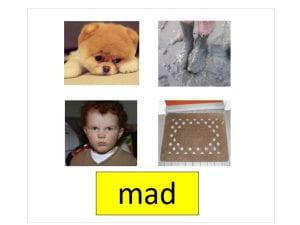As noted earlier, once Anna was competent with sound blending and knew 6-7 letter sounds, we started to introduce her to decoding skills. It was important for Anna to learn decoding skills so that she would be able to try to read any new word.
Decoding requires the integration of letter sound knowledge and sound blending. In order to decode words, Anna needed to
- Recognize the letters in the word
- Retrieve the sound for each letter in sequence
- Hold these sounds in working memory in sequence
- Blend these sounds together to determine the word
- Retrieve the meaning of the word
Goal for Decoding
Anna’s goal for instruction in decoding was as follows:
Anna will decode a written word and select a picture of the target word from a field of 4 options or say the word or sign the word with at least 80% accuracy over at least 2 consecutive sessions.
Teaching Decoding Skills
In this task, the instructor first presented Anna with 4 pictures as possible response options. She then presented a written word to Anna. Anna had to retrieve the letter sounds for each of the letters in sequence and blend the sounds to determine the target word. She could then respond by selecting the picture of the target word from the array of pictures, signing the target word, or using a speech approximation where possible.
We started with short words that were regular and just included three sounds (i.e., consonant vowel consonant words such as mom, nap, mad, dog, cat, dad). We only targeted words that included the letter sounds that Anna already knew. As she learned new letters and sounds, we introduced new words for decoding.

Since Anna was not able to clearly say all of the words introduced for decoding, we knew it might be difficult to determine areas of difficulty if she was incorrect in her responses. So we carefully selected the pictures that we provided as response options for each target word. For example, if the target word was “mad”, we included one picture that represented the target word and then one that changed only the initial letter sound (e.g., sad), one that changed only the middle letter sound (e.g., mud), and one that changed only the final letter sound (e.g., mat). We always varied the location of the correct response in the array of choices. After each instructional session, we conducted an error analysis to determine areas of difficulty for Anna. We looked for patterns in the data. Was she having difficulty primarily with the final letter sounds? Or the middle letter sounds? Or was she always selecting the picture in the same location suggesting that she did not understand the task?
When Anna was first learning to decode, it was challenging for her to do so. We provided her with scaffolding support to help her learn this new skill.
- First we modeled how to decode. We pointed to the letters in sequence and said their sounds, blended the sounds together, said the target word, and then pointed to the correct picture from the array of pictures provided.
- Then we provided her with guided practice, helping her to decode.
- Initially we helped Anna trace under the letters in each word
- We said the sounds as we pointed to each letter in sequence
- Since Anna already knew sound blending skills, we waited for her to blend the sounds together in her head and point to the picture of the target word.
- Over time as Anna developed her skills, we gradually faded the support until she was able to independently decode words.
- We waited for her to say the letter sounds as we pointed to each letter
- We always provided her with feedback on her responses.
In this video, you will see Anna during early instruction in decoding single words. She has a book with 10 words and photos; there is a new word and a photo of the word on each page. The instructor covers the photo while Anna decodes the word. The instructor helps Anna point to the letters one at a time in sequence and Anna says each letter sound. She then signs the word or uses a speech approximation. Then she checks the photo to see if she is correct. In this video, you will see her independently read 3 words (cat, mad, dad) and you will see the instructor provide her with some scaffolding support to read the word, cup. You will notice that sometimes Anna repeats a letter sound several times before she says the next letter sound. We are working with her to just say each sound once and then blend the sounds together.
In addition to instruction in decoding, we also continued to teach Anna new letter sounds. As she acquired a new letter and sound, we incorporated new words for decoding that used these new letters and sounds as well as the ones she had acquired previously.
Over time, as Anna developed her skills independently decoding regular consonant-vowel-consonant words, we targeted longer words, including regular consonant-consonant-vowel-consonant words such as stop and consonant-vowel-consonant-consonant words such as wind.
Later we taught her specific decoding rules such as the “silent e” at the end of words that results in a long vowel sound as in words such as “like”.
For more information on teaching decoding skills to children with complex communication needs like Anna, visit our website on Literacy Instruction.